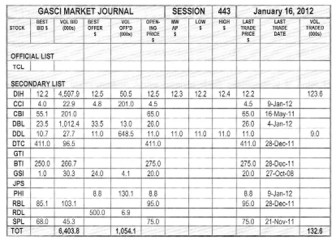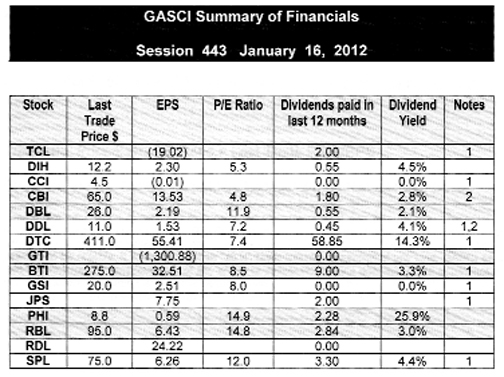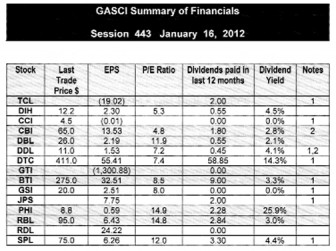GASCI (www.gasci.com/telephone Nº 223-6175/6) reports that session 443’s trading results showed consideration of $1,614,180 from 132,600 shares traded in 8 transactions as compared to session 442 which showed consideration of $154,401 from 20,000 shares traded in 8 transactions. The stocks active this week were DIH and DDL .

Demerara Distillers Limited’s (DDL) two trades totalling 9,000 shares represented 6.79% of the total shares traded. DDL’s shares were traded at a Mean Weighted Average Price (MWAP) of $11.0, which showed no change from its previous close. DDL’s trades contributed 6.13% ($99,000) of the total consideration. Both of DDL’s trades were at $11.0.
NOTES:
Best bid: The highest price that a buyer is willing to pay for a security.
Best offer: The lowest price at which a seller is offering to sell securities.
1 — Interim Results
2 — Prospective Dividends
3 — Shows year-end EPS but Interim Dividend
EPS: earnings per share for 12 months period to the date the latest financials have been prepared. These include:
2005 – Final results for GTI.
2008 – Final results for PHI.
2009 – Final results for RDL.
2011 – Interim results for TCL, CCI, DDL, DTC, BTI, GSI, JPS and SPL.
2011 – Final results for DIH, CBI, DBL and RBL.
As such, some of these EPS calculations are based on un-audited figures.
P/E Ratio: Price/Earnings Ratio = Last Trade Price/EPS
Dividend yield = Dividends paid in the last 12 months/last trade price.
TERM OF THE WEEK
Asset/Liability Management: Active balance sheet management in order to maximize returns and minimize interest rate risk. Thus, a bank might use an interest rate swap to convert a fixed-rate loan (asset) to match the interest basis of its floating-rate deposits (liabilities)..
Source: Dictionary of Financial and Securities Terms







